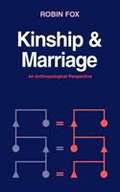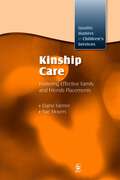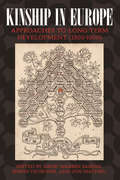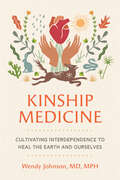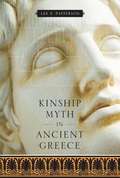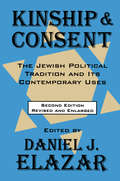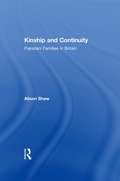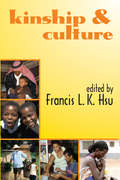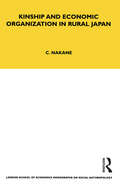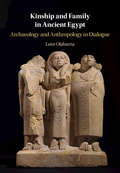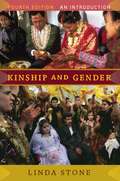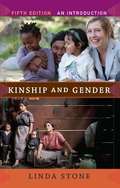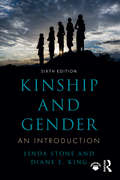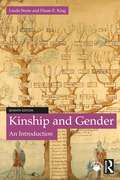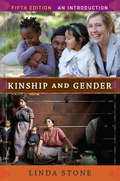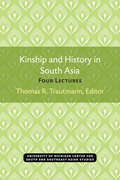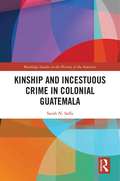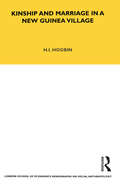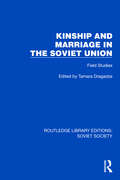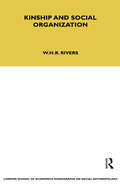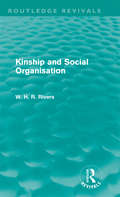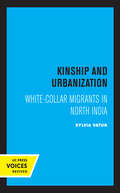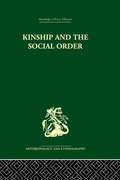- Table View
- List View
Kinship And Marriage: An Anthropological Perspective (Cambridge Studies In Social And Cultural Anthropology #50)
by Robin FoxRobin Fox's study of systems of kinship and alliance has become an established classic of the social science literature. It has been praised above all for its liveliness of style and clarity of exposition in an area that students and general readers have found difficult to master. It was the first attempt to produce an overview of this central subject and has maintained its unique position over the years. Fox's reconciliation of 'descent' and 'alliance' theories, and his 'deductive' approach to the logic of kinship systems based on four universal premises, give the book its distinctive flavour and make it not only the best available introductory text but a contribution to theory in its own right. It has been used throughout the world as an introduction for both academic and lay readers and has been translated into numerous languages.
Kinship Care: Fostering Effective Family and Friends Placements
by Elaine Farmer Sue MoyersChildren are frequently cared for by relatives and friends when parents, for whatever reason, are unable to care for their children themselves. Yet there has been very little information about how well children do when placed with kin or how safe they are in these placements. This book compares formal kinship care to traditional foster placements in order to ascertain which children are placed with kin, in what circumstances, how well such children progress, and how often these placements disrupt. The authors explore whether children placed with family and friends fare better or worse than other foster children, what services are provided and needed, and how kin care is experienced by carers, children and social workers. This book will be essential reading for social workers, policy makers, students and all those working with looked-after children, and will enable local authorities to make informed decisions about where best to place children and the support needed by family and friend carers.
Kinship In Europe
by David Warren Sabean Jon Mathieu Simon TeuscherSince the publication of Philippe Ariès's book, Centuries of Childhood, in the early 1960s, there has been great interest among historians in the history of the family and the household. A central aspect of the debate relates the story of the family to implicit notions of modernization, with the rise of the nuclear family in the West as part of its economic and political success. During the past decade, however, that synthesis has begun to break down. Historians have begun to examine kinship - the way individual families are connected to each other through marriage and descent - finding that during the most dynamic period in European industrial development, class formation, and state reorganization, Europe became a "kinship hot" society. The essays in this volume explore two major transitions in kinship patterns - at the end of the Middle Ages and at the end of the eighteenth century - in an effort to reset the agenda in family history.
Kinship Medicine: Cultivating Interdependence to Heal the Earth and Ourselves
by Wendy Johnson MD, MPHFor fans of Braiding Sweetgrass, The Future We Choose, and The Blue Zones, a book about the effect our relationship to nature has on our well-being and health.Our modern way of living is incompatible with our survival. Most of us intuitively know this truth, but almost everything in our society encourages us to ignore it. Dr. Wendy Johnson confronts this undeniable fact and breaks down how we think and act every day in ways that undermine our individual and collective well-being.The antidotes to many of the causal factors of poor health—loneliness, industrial diets, systemic inequality, fear of death, profit-based healthcare—are relational, with each other and with the living earth. Through evidence from public health, sociology, anthropology, human ecology, and her experience as a family physician, Dr. Wendy Johnson will show you how:We must incorporate an &“ecosystem&” perspective into modern medicineWhat you ingest and where you live can reinforce or upset your body&’s delicate balanceEliminating one organism in an ecosystem can affect all the othersHistories of trauma can be passed down for generationsRekindling our relationships to non-human life is essential to our well-beingBeing closer to death can release some of its power over usActions of communities will be stronger and more lasting than any individual effortsYou will leave with a clear vision of what a new society might look like, methods to accomplish this transformation, and concrete examples of where it is being done successfully.
Kinship Myth in Ancient Greece
by Lee E. PattersonIn ancient Greece, interstate relations, such as in the formation of alliances, calls for assistance, exchanges of citizenship, and territorial conquest, were often grounded in mythical kinship. In these cases, the common ancestor was most often a legendary figure from whom both communities claimed descent. In this detailed study, Lee E. Patterson elevates the current state of research on kinship myth to a consideration of the role it plays in the construction of political and cultural identity. He draws examples both from the literary and epigraphical records and shows the fundamental difference between the two. He also expands his study into the question of Greek credulity--how much of these founding myths did they actually believe, and how much was just a useful fiction for diplomatic relations? Of central importance is the authority the Greeks gave to myth, whether to elaborate narratives or to a simple acknowledgment of an ancestor. Most Greeks could readily accept ties of interstate kinship even when local origin narratives could not be reconciled smoothly or when myths used to explain the link between communities were only "discovered" upon the actual occasion of diplomacy, because such claims had been given authority in the collective memory of the Greeks.
Kinship and Consent: Jewish Political Tradition and Its Contemporary Uses
by Daniel L. ElazarA major dimension of modern Jewish life has been the revival of conscious political activity on the part of the Jewish people, whether through reestablishment of the State of Israel, new forms of diaspora community organization, or the common Jewish fight against anti-Semitism. Precisely because contemporary Jewry has moved increasingly toward self
Kinship and Continuity: Pakistani Families in Britain
by Alison ShawKinship and Continuity is a vivid ethnographic account of the development of the Pakistani presence in Oxford, from after World War II to the present day. Alison Shaw addresses the dynamics of migration, patterns of residence and kinship, ideas about health and illness, and notions of political and religious authority, and discusses the transformations and continuities of the lives of British Pakistanis against the backdrop of rural Pakistan and local socio-economic changes. This is a fully updated, revised edition of the book first published in 1988.
Kinship and Culture
by Francis L. K. HsuAt one time Francis L.K. Hsu put forth a hypothesis on kinship that proposed a functional relationship between particular kinship systems and behavior patterns in particular cultural contexts. The controversy provoked among cultural anthropologists by this hypothesis is reflected in this book, which points the way toward more fruitful investigations of kinship in cultural and psychological anthropology.Hsu's hypothesis offers an alternative to the study of kinship as a mathematical game and to the treatment of fragmentary aspects of child-rearing practices as major causal factors in culture. Considering the kinship system as the psychological factory of culture, Hsu's aim is to discover the crucial forces in each system that shape the interpersonal orientation of the individual, which forms the individual's basis for adequate functioning as a member of his society and which, in turn, provides his culture with a basis for continuity and change. His central hypothesis is that the attributes of the dominant dyads in a given kinship system (such as father-son or mother-daughter) tend to determine the attitudes and action patterns that the individual in such a system develops toward other relationships in that system as well as toward his relationships outside of it.The topics are varied, ranging from the link between dyadic dominance and household maintenance, to role dilemmas and father-son dominance, to sex-role identity and dominant kinship relationships. The editor has contributed an introduction, an original essay on kinship and patterns of social cohesion, and a summary chapter to bring coherence to the diversity of opinion stated. This new presentation of Hsu's hypothesis, together with its discussion by eminent anthropologists and its recommendations for future research in the area, is an important addition to the literature on kinship.
Kinship and Economic Organisation in Rural Japan (LSE Monographs on Social Anthropology #Vol. 32)
by Chie NakaneIn this essay the author presents the principles of one important sector of social organization in Japan, and establish its framework. Japanese kinship structure, with its multiple historical and local factors, and unlike that of the Chinese or of the Hindus, does not belong to the category of unilineal systems, nor to any kind of descent pattern found in the published literature of social anthropology. Social anthropology, developed by micro-synchronic studies of simpler societies, and with its major analysis devoted to descent systems, has to face in Japan a critical methodological test. In this essay, the author, as a social anthropologist, want to overcome these drawbacks of anthropological method, and to demonstrate one of the new approaches by which an anthropologist can cope with the data from a sophisticated society
Kinship and Family in Ancient Egypt: Archaeology and Anthropology in Dialogue
by Leire OlabarriaIn this interdisciplinary study, Leire Olabarria examines ancient Egyptian society through the notion of kinship. Drawing on methods from archaeology and sociocultural anthropology, she provides an emic characterisation of ancient kinship that relies on performative aspects of social interaction. Olabarria uses memorial stelae of the First Intermediate Period and the Middle Kingdom (ca.2150–1650 BCE) as her primary evidence. Contextualising these monuments within their social and physical landscapes, she proposes a dynamic way to explore kin groups through sources that have been considered static. The volume offers three case studies of kin groups at the beginning, peak, and decline of their developmental cycles respectively. They demonstrate how ancient Egyptian evidence can be used for cross-cultural comparison of key anthropological topics, such as group formation, patronage, and rites of passage.
Kinship and Gender
by Linda StoneDesigned for undergraduate courses in kinship, gender, or the two combined, Linda Stone's Kinship and Gender is the product of years of teaching. The topic of kinship comes alive when linked to gender issues; conversely, the cross-cultural study o. . .
Kinship and Gender
by Linda StoneDoes kinship still matter in today's globalized, increasingly mobile world? Do family structures continue to influence the varied roles that men and women play in different cultures? Answering with a resounding "yes!", Linda Stone offers a lively introduction to and working knowledge of kinship. She firmly links these concepts to cross-cultural gender studies, illuminating the malleable nature of gender roles around the world and over time. Written to engage students, each chapter provides key terms and useful generalizations gleaned through cross-cultural research on the interplay of kinship and gender in both traditional societies and contemporary communities. Detailed case studies help students understand how such generalizations are experienced "in real life. " Stone also considers the ramifications of current social problems and recent developments in reproductive technology as she demonstrates the relevance of kinship and gender to students' lives. The fully-revised 5th edition features discussion of cross-cultural examples complimented by expanded coverage of kinship and gender dynamics within the United States. Stone considers current evolutionary research on kinship and gender, and offers new case studies addressing international adoptions and polygynous marriage. An entirely new chapter explores the globalization of kinship in the 21st century. The result is a broad and captivating exploration of anthropological approaches to family and gender.
Kinship and Gender, 4e
by Linda StoneDesigned for undergraduate courses in kinship, gender, or the two combined, Linda Stone's Kinship and Gender is the product of years of teaching. The topic of kinship comes alive when linked to gender issues; conversely, the cross-cultural study of gender benefits from a working knowledge of kinship. This essential book successfully merges these two disciplines, demonstrating their relevance to students' lives and enhancing students' understanding of other cultures. Fourteen case studies throughout the book illuminate the intricate connections between kinship and gender across a variety of cultural groups. The fourth edition features a new chapter that reveals how kinship structures and related gender roles underlie many current social problems around the world. Also new to this edition are two original case studies, discussion questions, and listings of useful websites to aid further research.
Kinship and Gender, 5e
by Linda StoneDoes kinship still matter in today's globalized, increasingly mobile world? Do family structures continue to influence the varied roles that men and women play in different cultures? Answering with a resounding "yes!", Linda Stone offers a lively introduction to and working knowledge of kinship. She firmly links these concepts to cross-cultural gender studies, illuminating the malleable nature of gender roles around the world and over time.Written to engage students, each chapter provides key terms and useful generalizations gleaned through cross-cultural research on the interplay of kinship and gender in both traditional societies and contemporary communities. Detailed case studies help students understand how such generalizations are experienced "in real life." Stone also considers the ramifications of current social problems and recent developments in reproductive technology as she demonstrates the relevance of kinship and gender to students' lives.The fully-revised 5th edition features discussion of cross-cultural examples complimented by expanded coverage of kinship and gender dynamics within the United States. Stone considers current evolutionary research on kinship and gender, and offers new case studies addressing international adoptions and polygynous marriage. An entirely new chapter explores the globalization of kinship in the 21st century. The result is a broad and captivating exploration of anthropological approaches to family and gender.
Kinship and Gender: An Introduction
by Linda Stone Diane E. KingDoes kinship still matter in today’s globalized, increasingly mobile world? Do family structures continue to influence the varied roles that men and women play in different cultures? Answering with a resounding ‘yes!’, Linda Stone and Diane E. King offer a lively introduction to and working knowledge of kinship. They firmly link these concepts to cross-cultural gender studies, illuminating the malleable nature of gender roles around the world and over time. Written to engage students, each chapter in Kinship and Gender provides key terms and useful generalizations gleaned through research on the interplay of kinship and gender in both traditional societies and contemporary communities. Detailed case studies and cross-cultural examples help students understand how such generalizations are experienced in real life. The authors also consider the ramifications of current social problems and recent developments in reproductive technology as they demonstrate the relevance of kinship and gender to students’ lives. The fully-revised sixth edition contains new case studies on foster parenting in the United States and on domestic violence. It provides new material on pets as family members and an expanded discussion of the concept of lineal masculinity. There is also a comparison of the adoption of new reproductive technologies in Israel with other countries, along with a discussion of the issue of transnational movements in the use of these technologies.
Kinship and Gender: An Introduction
by Linda Stone Diane E. KingThis fully revised seventh edition of Kinship and Gender: An Introduction explores kinship in today’s globalized, increasingly mobile world, and how family structures continue to influence the varied roles that men and women play in different cultures. Written to engage students, each chapter provides key terms and useful generalizations gleaned through research on the interplay of kinship and gender in both traditional societies and contemporary communities. Detailed case studies and cross-cultural examples help students understand how such generalizations are experienced in real life. The authors also consider the ramifications of current social problems and recent developments in reproductive technology as they demonstrate the relevance of kinship and gender to students’ lives. The new edition contains a revised introduction highlighting the disaggregation of marriage and reproduction; new sections on third gender, nonbinary, and trans identities; new case studies on spiritual kinship; as well as explorations of genetic and ancestral kinship paradigms, new reproductive technologies, and a more robust global perspective throughout. Pedagogical features include suggestions for classroom media, a glossary, an appendix, and downloadable PowerPoint slides.Kinship and Gender: An Introduction provides a broad, yet nuanced introduction to the field, and is essential reading for students taking their first steps into anthropology, gender studies, and sociology.
Kinship and Gender: An Introduction
by Linda StoneDoes kinship still matter in today's globalized, increasingly mobile world? Do family structures continue to influence the varied roles that men and women play in different cultures? Answering with a resounding ?yes!?, Linda Stone offers a lively introduction to and working knowledge of kinship. She firmly links these concepts to cross-cultural gender studies, illuminating the malleable nature of gender roles around the world and over time.Written to engage students, each chapter provides key terms and useful generalizations gleaned through cross-cultural research on the interplay of kinship and gender in both traditional societies and contemporary communities. Detailed case studies help students understand how such generalizations are experienced ?in real life.? Stone also considers the ramifications of current social problems and recent developments in reproductive technology as she demonstrates the relevance of kinship and gender to students' lives.The fully-revised fifth edition features discussion of cross-cultural examples complimented by expanded coverage of kinship and gender dynamics within the United States. Stone considers current evolutionary research on kinship and gender, and offers new case studies addressing international adoptions and polygynous marriage. An entirely new chapter explores the globalization of kinship in the 21st century. The result is a broad and captivating exploration of anthropological approaches to family and gender.
Kinship and History in South Asia: Four Lectures (Michigan Papers On South And Southeast Asia)
by Thomas R. TrautmannKinship and History in South Asia presents four papers given at a small conference of kinship studies scholars, “Kinship and History in South Asia,” at the University of Toronto in 1973. They draw upon one another and show several common concerns, particularly the theoretical importance of Dravidian systems. Yey they remain specialist studies, each within its own raison d’être. Brendra E. F. Beck contributes a study of the “kinship nucleus” in Tamil folklore, Levi-Straussian both in its treatment of kinship and of mythology. George L. Hart’s study of woman and the sacred in the ancient Tamil literature of the Sangam attempts to elucidate this literature in its own terms, and also to relate it to Beck’s “kinship nucleus.” Thomas R. Trautmann presents a critical examination of the evidence for cross-cousin marriage in early North India, attempting to determine historical fact from literary materials. Narendra K. Wagle offers a survey of the kinship categories to be found in the Pali Jatakas.
Kinship and Incestuous Crime in Colonial Guatemala
by Sarah N. SaffaKinship and Incestuous Crime in Colonial Guatemala examines social relations in colonial Guatemala through the lens of incest. Using a combination of qualitative and quantitative analyses of incest trials from the Spanish secular courts, this study shows that incest codes were not homogenous nor were its various forms equally condemned. Further, incest codes and the criminal process impacted the articulation of kinship and contributed to the racialization of kin behavior. Colonial actors of all sorts were proficient at using these types of distinctions as they negotiated various crises in their lives. The models of relatedness created within incestuous crime ultimately foreshadowed changes in marriage proscriptions and continued racial polarization following independence from Spain. Overall, this study demonstrates how the lens of incest can add further nuance to our understanding of social relations in a given area. Incest codes force latent divisions between kin to the surface and can provide individuals with multiple avenues to creatively manage interpersonal relationships. They also afford a fruitful arena in which to explore social inequalities in society and mechanisms of culture change. This book will appeal to anyone interested in Latin America or engaged in the fields of kinship, gender, or sexuality studies.
Kinship and Marriage in a New Guinea Village (London School Of Economics Monographs On Social Anthropology Ser. #Vol. 26)
by H. Ian HogbinThe economic and political systems, legal code and religious beliefs of the people of the New Guinea village of Busama were analysed by H. Ian Hogbin in his earlier work, Transformation Scene (1951). In this new study founded on field work carried out at intervals over a seven year period, he is concerned primarily with the individual in his relations with the kinship structure. He takes a typical Busama through a full span of life, from birth through infancy, childhood, adolescence, and marriage to maturity and death; and he shows how each stage in the individual's life involves a change in his kinship relationships and responsibilities. This approach gives the professional anthropologist a set of carefully presented data analysed in line with the contemporary emphasis on seeing the relations between kin in the context of the local community, and it also offers the general reader an enjoyable and authentic account of the intimacies of Melanesian life.
Kinship and Marriage in the Soviet Union: Field Studies (Routledge Library Editions: Soviet Society)
by Tamara DragadzeKinship and Marriage in the Soviet Union (1984) presents articles by established Soviet anthropologists, writing on kinship and marriage in the countries of the USSR. They represent all the main Soviet regions and display the way in which scholars handle their data within a particular theoretical framework. The collection demonstrates both the style of Soviet scholars who write in social anthropology, and the richness of living traditions among the diverse nationalities of the Soviet Union.
Kinship and Social Organisation
by W. H. RiversW. H. R. Rivers, who has been called 'the founder of the modern study of social organization', exerted an immense influence on his contemporaries and successors. This volume reprints three of his lectures, delivered in 1913 and first published in 1914, which provide a short and brilliant exposition of his theoretical approach, and are exemplary of his handling of ethnographic evidence. His theme is the relationship between kinship terminologies and social organization, more particularly forms of marriage, a subject still of lively theoretical interest. Also included is the same author's The Genealogical Method of Anthropological Enquiry, first published in 1910, a classic of anthropological methodology, and Professor Raymond Firth of the London School of Economics and Professor David Schneider of the University of Chicago provide commentaries estimating the past and present importance of Rivers in British and American Anthropology respectively.
Kinship and Social Organisation (Routledge Revivals #Vol. 34)
by W. H. RiversFirst published in 1914, W. H. R. Rivers' hugely influential study was the first to effectively demonstrate the close connection between methods of denoting relationship or kinship and forms of social organisation, including those based on different forms of the institution of marriage. He also shows that the terminology of relationship has been rigorously determined by social conditions and that, therefore, systems of relationship furnish us with a most valuable instrument in studying the history of social institutions. This series of lectures was originally delivered by the author in May 1914, at the London School of Economics. They are based on the experiences of the Percy Sladen Trust Expedition to Melanesia in 1908.
Kinship and Urbanization: White-Collar Migrants in North India (Center for South and Southeast Asia Studies, UC Berkeley)
by Sylvia VatukThis title is part of UC Press's Voices Revived program, which commemorates University of California Press’s mission to seek out and cultivate the brightest minds and give them voice, reach, and impact. Drawing on a backlist dating to 1893, Voices Revived makes high-quality, peer-reviewed scholarship accessible once again using print-on-demand technology. This title was originally published in 1972.
Kinship and the Social Order.: The Legacy of Lewis Henry Morgan
by Meyer FortesOriginally published in the UK in 1970. The central argument of this book is that the structuralist theory and method developed by British and American anthropologists in the study of kinship and social organization are the direct descendants of the researches of Lewis Henry Morgan. Re-examining Morgan's work, the book demonstrates how a tradition of mis-interpretation has disguised the true import of Morgan's discoveries and ideas for Rivers and Radcliffe-Brown and the generation of anthropologists inspired by them.
